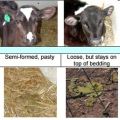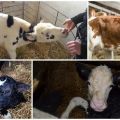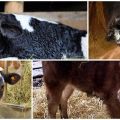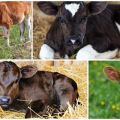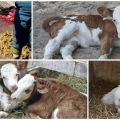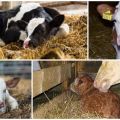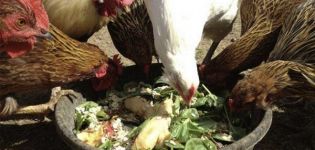Symptoms and Diagnosis of Calf Hernia, What to Do and How to Treat
Pets are not only susceptible to injury and infectious diseases. They may experience lesions associated with various pathologies, including congenital ones. One of the most common problems is calf hernias, which can cause dangerous complications if treated incorrectly or not at all. They do not belong to infections, so they do not threaten the entire herd, but the calf can be killed.
What is this pathology
A hernia is a protrusion of internal organs, most often the intestines, through a hole formed in the connective tissues. If the problem is not dealt with in a timely manner, the hernia may begin to increase in size due to the further extension of the loops of the intestines and organs outward.
This can cause strangulation, circulatory disorders and intestinal obstruction. Such conditions not only cause severe pain and discomfort to the animal, but when neglected can cause the death of young animals.
The causes of the disease
Hernia can be of the following types:
- Congenital. It occurs due to a hereditary tendency to muscle weakness and low tissue elasticity. Also, the reason for the appearance of this type of hernia is the expansion of the umbilical ring.
- Acquired. This pathology develops due to trauma, for example, a blow to the abdomen, severe bruising from a fall, and also due to the ingress of pathogens into an open wound formed during the cutting of the umbilical cord.
If the abdominal wall is weak, the protrusion of organs and parts of the intestine will continue due to internal pressure, therefore, it is absolutely impossible to ignore such a pathology.
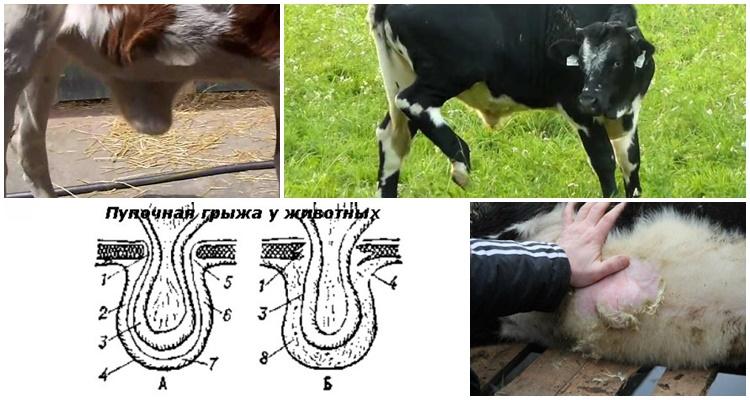
Symptoms of the disease
In the initial stages of the development of the disease, its signs may not be striking, since at this time the animal still feels good and does not suffer from pain. But hernia in calves can be visible to the naked eye, so veterinarians and owners need to carefully examine the offspring immediately after birth, and then regularly during the first weeks and months of the animal's life.
In the initial stages, it can be adjusted by light pressure of the fingers, but with the slightest effort or movement of the calf, the hernia comes out again.If the problem is at an advanced stage, part of the intestine, and sometimes other organs, gets into the umbilical opening. This leads to the following symptoms:
- Soreness, especially when moving or touching the affected area.
- Slight rise in temperature.
- Loss of appetite.
- Disorders of the excretory function.
- Anxiety, restlessness or lethargy in the calf.
It is impossible to ignore such signs, because at any moment the hernia can be infringed, and this carries an immediate threat to life.
Diagnostic measures
Diagnosis is carried out visually and by palpation, the diagnosis is confirmed by the presence of characteristic signs. On examination, the veterinarian detects a specific protrusion in the navel that can be mobile and painful. The presence of a hernia is confirmed by an increase in temperature by several degrees, impaired appetite and stool, changes in the behavior of the animal.
How to properly treat an umbilical hernia in calves
If the hernia is small (up to 30 millimeters in diameter), it is not life threatening. The animal must be monitored. Most often, nothing has to be done, since during the year of the life of the young, the hernia can disappear on its own due to the strengthening of the muscular corset and the closure of the umbilical opening.
In all other cases, compulsory treatment will be required, which is performed in various ways.
Conservative treatment
In the event that a hernia in calves is detected in a timely manner, when it is still insignificant, there is no infringement, inflammation and adhesions, babies can be helped by repositioning.
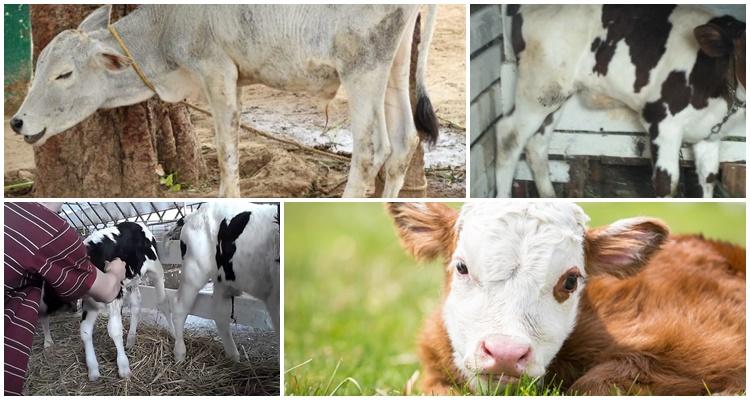
To do this, the veterinarian gently massage the hernia area, stimulating the relaxation of the muscle ring. Then he delicately, without unnecessary effort, sets the fabrics released into the hole. To prevent repeated protrusion outward, the place of the hernia is sealed with a dense plaster, additionally fixed with a special bandage. In order for this treatment to proceed without complications and to bring relief, the calf needs to be restful for about a week.
In the future, the injured animal must be protected from physical exertion, blows and injuries.
Surgical intervention
If a hernia in a calf is inflamed, there is suppuration, a loop of intestine or other tissue has entered the hole, there is an infringement, adhesions threatening necrosis, urgent surgical intervention will be required.
The operation is performed by a veterinarian under local anesthesia. The navel area is cleaned of fur, disinfected and anesthetized. The incision of the abdominal wall is made 20 millimeters from the edge of the hernia. The resulting bag is removed, if necessary, the inflamed tissues are cleaned, the organs protruding outward are carefully set, and the hole is sutured. To prevent recurrence of hernia in calves, fixing brackets are applied to the operation site.

Postoperative period
After the intervention, the animal is provided with rest, underlain with clean straw, given light, well-digestible food and constant access to clean drinking water. If necessary, the calf is injected with antibiotics, as well as pain relievers if necessary. On the fifth or tenth day after the operation, the stitches are removed, but the condition of the calf is continued to be monitored. If his temperature rises, discharge or pus appears, seams diverge, it is necessary to urgently take action and call a veterinarian, since dangerous complications are possible.
Consequences of not being treated
Umbilical hernia in calves is a life-threatening pathology that requires careful attention, especially if it is infringed. It is extremely dangerous to try to cope with this condition on your own, since adhesions may form when infringed.If you try to straighten the bowel with force, it can lead to rupture and spillage of contents into the abdominal cavity. This threatens with an extremely serious consequence - the development of peritonitis, in which there is a high risk of losing a calf.
If hernias in calves are not treated in a timely manner, this can cause the following complications:
- Infringement, leading to the development of necrosis and tissue rupture.
- Formation of adhesions, excluding the possibility of repositioning a hernia in a calf without surgery.
- Inflammatory process (phlegmon) of the hernial sac. It can spread to the abdominal wall and pass to the affected part of the organs, accompanied by an increase in temperature and a sharp deterioration in the general well-being of the animal. The condition threatens with the rapid spread of infection, damage to vital organs, general intoxication and the development of sepsis (blood poisoning).
It is impossible to assume that any hernia in calves will go away on its own. If it is detected, the animal must be under the supervision of a veterinarian.
Prevention
If the formation of an umbilical hernia in offspring is associated with heredity, it is impossible to prevent it, but there is a chance to cope with it in the early stages. In other situations, it is possible to protect the animal from the formation of a hernial sac by keeping the calf in comfortable conditions, avoiding injury, blows, or falling.
Scientists from the United States believe that an infection that gets into the umbilical wound is a risk factor, so frequent treatment with available antiseptics, for example, tincture of iodine, can serve as a prevention method. This will help speed up healing and reduce your risk.
Also, a preventive method is the use of plastic clamps, which prevent the expansion of the umbilical ring and the formation of hernia in calves.
This condition is often found in newborns and babies, but it needs a competent approach to avoid painful and risky consequences. If you do not pay attention to the presence of a hernia, this will cause the gradual development of hernia and inflammation, which can lead to a sudden complication and death of a young animal.








